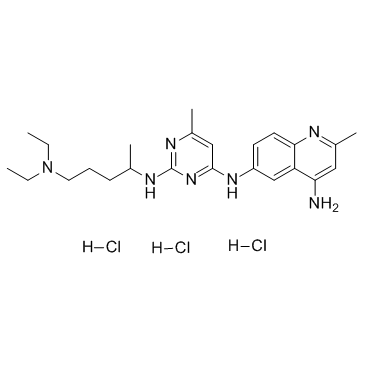1177865-17-6
| Name | 6-N-[2-[5-(diethylamino)pentan-2-ylamino]-6-methylpyrimidin-4-yl]-2-methylquinoline-4,6-diamine |
|---|---|
| Synonyms |
N-(2-{[5-(Diethylamino)-2-pentanyl]amino}-6-methyl-4-pyrimidinyl)-2-methyl-4,6-quinolinediamine
trihydrochloride 4,6-Quinolinediamine, N-[2-[[4-(diethylamino)-1-methylbutyl]amino]-6-methyl-4-pyrimidinyl]-2-methyl- N-(2-{[5-(diethylamino)pentan-2-yl]amino}-6-methylpyrimidin-4-yl)-2-methylquinoline-4,6-diamine NSC 23766 NSC 23766 (trihydrochloride) |
| Description | NSC 23766 trihydrochloride is an inhibitor of Rac1 activation. |
|---|---|
| Related Catalog | |
| In Vitro | NSC 23766 (100 μM) treatment effectively inhibits polar body emission in a dose-dependent manner. NSC 23766 (200 μM) increases the percentage of morphologically abnormal spindles of oocytes. In NSC 23766-treated oocytes, the p-MAPK protein expression is significantly decreased[2]. NSC23766 (50 μM) plus 100 ng/mL Jagged1, GDF9 and BMP15, reduces the number of germLine cell cysts and increases the number of primordial follicles[3]. NSC23766 significantly inhibits GTP-Rac1 activity and phosphorylation of Rac1-PAK, ERKs and p38 MAPK in the spinal dorsal horn neurons[4]. |
| In Vivo | NSC23766 (2.5 mg/kg/day, i.p.) significantly attenuates the onset of spontaneous diabetes in NOD mice, without significant effects on the growth (body weights) of the mice. NSC23766 significantly increases the expression of Rac1 and CHOP, a marker for ER-stress, in islets from NOD mice[1]. |
| Kinase Assay | Briefly, fresh spinal cord tissue of the lumbar enlargement is homogenised in the presence of protease and phosphatase inhibitors and lysed with buffer. After being centrifuged at 12,000× g for 5 min at 4°C, the supernatants are collected and incubated with PAK-PBD beads at 4°C on a rotator for 1 h and then the beads are pelleted through centrifugation at 5000× g for 3 min at 4°C. The resulting pellet is resuspended in LaemmLi buffer and boiled for 2 min. The bead samples are subjected to Western blot analysis. Total Rac1 in each sample is also determined by Western blot analysis. |
| Animal Admin | Balb/c control and NOD mice are at 7 weeks of age and are divided into four groups (n=8/group). At 8 weeks of age two groups of experimental animals (Balb/c and NOD) receive NSC23766 (2.5 mg/kg/day, i.p./daily) and other two groups, which serve as control Balb/c and NOD mice and receive equal volume of saline. The body weights and blood glucose are monitored every week for 34 weeks. |
| References |
| Density | 1.2±0.1 g/cm3 |
|---|---|
| Boiling Point | 632.4±65.0 °C at 760 mmHg |
| Molecular Formula | C24H38Cl3N7 |
| Molecular Weight | 530.96 |
| Flash Point | 336.2±34.3 °C |
| PSA | 91.99000 |
| LogP | 3.86 |
| Appearance | white to beige |
| Vapour Pressure | 0.0±1.9 mmHg at 25°C |
| Index of Refraction | 1.647 |
| Storage condition | ?20°C |
| Water Solubility | H2O: soluble10mg/mL, clear |
| Symbol |

GHS07 |
|---|---|
| Signal Word | Warning |
| Hazard Statements | H315-H319-H335 |
| Precautionary Statements | P261-P305 + P351 + P338 |
| Hazard Codes | Xi |
| Risk Phrases | 36/37/38 |
| Safety Phrases | 26 |
| RIDADR | NONH for all modes of transport |
